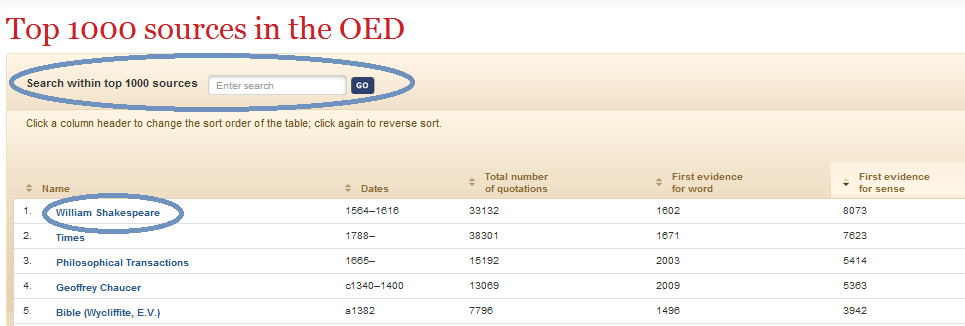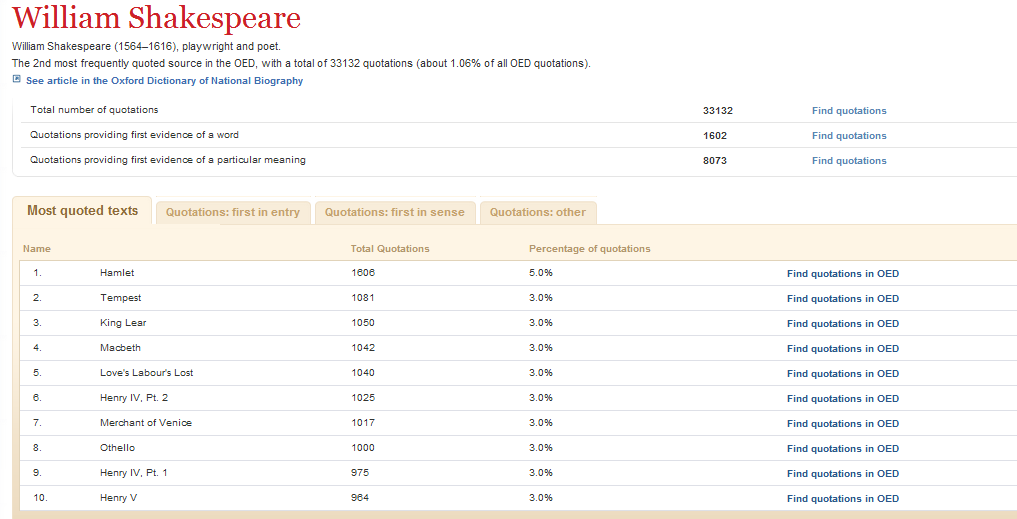The last special feature that will be introduced here is called Sources. This feature basically consists of a complex and multi-layered list naming the 1000 most frequently cited authors. They are listed according to the dates of their works, their total number of quotations, their first evidence for a word and first evidence for a sense in a quotation. The main page is easy to work with as it has a very clear structure that can – to a certain extent – be adjusted to the requirements of a specific query, e.g. the whole sequence of the appearing list can be rearranged by just one click on the head line of any given category (date, number of quotations or first evidence for word or sense).

Screen shot 4 main page Sources
The search button in the top left corner allows users to search for any of the authors listed e.g. Shakespeare. The website also claims to offer a search by work title e.g. Hamlet, but unfortunately such a search request fails. Searching for an author by name as well as just clicking on any of the blue marked names on the list, leads to a new corresponding page. This page provides further details of the specific author plus links to relevant dictionary entries. Corresponding pages are always organized in the same way. In the top left corner the respective name of the author, a brief bibliography (Lifetime, Occupation) and the total/percentage number of quotations in the OED is given. This short introduction is complemented by a companion link to the Oxford Dictionary of National Biography. Then there is another short overview list including figures of the following keywords: the total number of quotations, quotations providing first evidence of a word and quotations providing first evidence of a particular meaning. All these keywords have direct links to relevant and detailed OED lists. But the main interest for the researcher is – most certainly – not this basic information but the multi-layered table at the bottom of this page. Its first layer is concerned with the most quoted works of a specific author. All of these tables are chronologically organized starting with the most cited one. Taking Shakespeare as an example, his most cited work is Hamlet with a total of 1606 quotations in the OED. Moreover, each title is listed with figures of the total number/percentage of quotations and a link to view these quotations in detail. All following layers subdivide the quotations in different categories such as: first in entry, first in sense and other. These three layers are all alphabetically structured and give information about the specific definition of the word, the title of the work in which it appears, the date and also a link to the specific quotation.

Screen shot 5 companion page on Shakespeare
A practical use of this new OED feature for linguistic research could be to assist and facilitate queries such as comparisons of the language of individual authors living at the same time (done by Rohdenburg in section 5 of his chapter) or a diachronic analysis of a single author looking at the language variation and change in different works. It may also be conceivable to investigate if the language of different authors differs with regard to word senses.
Created with the Personal Edition of HelpNDoc: Free PDF documentation generator